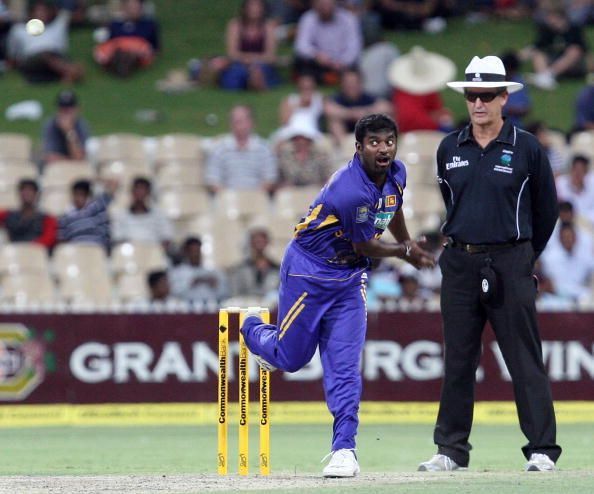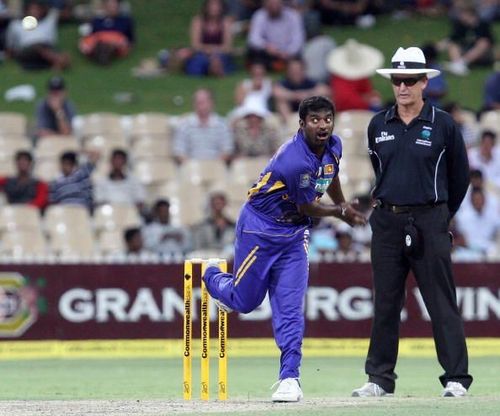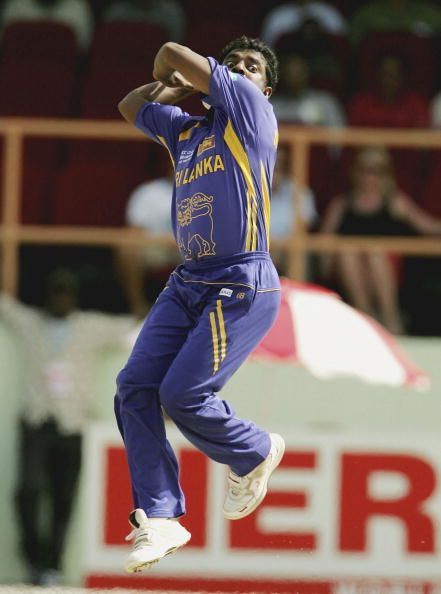
Cricket World Cup History: Muttiah Muralitharan, redefining the art of finger spin

Just when the obituary of Test cricket and spin bowling were being written there was a revival in both art forms in the early nineties. While the modern flag-bearers of leg-spin were Mushtaq Ahmed, Anil Kumble, Shane Warne, and Paul Strang, the torch-bearer among off-spinners was Muttiah Muralitharan. Saqlain Mushtaq joined him soon. When Muttiah Muralitharan first appeared, he was noted for the massive turn he derived off a long, rhythmic, diagonal run-up and a pronounced wrist action.
Yes, it was the rotating of the wrist, more than the flick of his fingers, that enabled Murali to extract phenomenal turn. In that sense, he was an unorthodox off-spinner. He would almost lob the ball in the manner of a shot-putter, albeit with a massive twist. In the early days, he was known more as the only Tamil in a Sinhalese team. He was then a one-dimensional bowler. Batsmen would be watchful against his big turners, but he was not too penetrative since he was predictable. Gradually he learnt new tricks. He developed a straighter delivery and one that left the right-hander. Subtle variations in flight and speed added to the batsmen’s woes.

An integral part of Arjuna Ranatunga’s successful team of the mid-nineties, the legend of Muralitharan kept growing. By the late nineties, he had emerged as arguably the greatest off-spinner of all time, certainly among the most penetrative. He now led the attack, and with able support from Chaminda Vaas, regularly decimated batting line-ups. Success, though, has its pitfalls. There was a row over his action. He was branded a chucker. Darrell Hair called him repeatedly for throwing, provoking Ranatunga into an on-field confrontation with the Australian umpire. Truce prevailed ultimately as it was ruled that since Muralitharan is congenitally unable to straighten his elbow, the bent-arm delivery was legal. There are still doubters. “Javelin thrower,” is how left-arm spin wizard of yesteryear Bishan Singh Bedi refers to him.
For all his incisiveness, Muralitharan sometimes found it difficult to bowl around the wicket and to left-handers. Perhaps these are co-related. Brian Lara scored prolifically against him, though hardly any bowler was able to tame the West Indies maestro. Be that as it may, Muralitharan went on to become the first to capture a mind-boggling 800 wickets in Test matches, and the top-wicket-taker in One-day Internationals too with 534 wickets, at brilliant averages. His magical bowling often obscured the fact that he was an electrifying fielder.
In Sri Lanka’s dream run of the 1996 World Cup, Muralitharan began with an economical stint of one for 37 off his 10 overs, dismissing a well-set Guy Whittall. Throughout the tournament he was never collared, conceding four runs an over or less in almost every innings.
His best effort was in the quarter-final when he bagged the vital wickets of Graeme Hick and Alec Stewart, conceding 37 runs in 10 overs. He may not have been a star performer in the championship triumph - that was reserved for the likes of Aravinda de Silva and Sanath Jayasuriya - but he was an important component of the unit, relentlessly bottling up the batsmen, never releasing the pressure and picking up the odd wicket or two.
By 1999, Muralitharan was approaching his best. As England ran away with the lung-opener, he was his immaculate self.
It was against South Africa that he showed glimpses of the great bowler that he was to become soon. After the Sri Lankan pacemen reduced South Africa to 69 for five, Daryll Cullinan and Jonty Rhodes tried to resurrect the innings. Muralitharan had Rhodes caught by Jayasuriya, and then as Shaun Pollock tried to attack him, took a return catch that ricocheted from Ranatunga’s legs. Cullinan lofted him and Vaas took a fine catch on the long-off boundary. South Africa slipped further from 103 for five to 122 for eight.
Lance Klusener bludgeoned some typically belligerent blows to carry the Proteas to within a touching distance of 200. Still, Muralitharan returned with a haul of three for 25 in his 10 overs. But the South African pace quintet was devastating, and the reigning champions lost two matches in a row. Muralitharan, though, became his country’s highest wicket-taker in One-day Internationals, going past Jayasuriya’s tally, ending the innings with 155 wickets in 112 matches.
There was some joy at last as the inspired Zimbabweans were defeated. Muralitharan took two for 29.
Also read: Unbreakable Test records held by Muttiah Muralitharan
With the Indian pair of Sourav Ganguly and Rahul Dravid wading into the Sri Lankan bowling, Muralitharan conceded 60 runs. This was the first time that he had given away more than 4.2 runs per over in 10 World Cup matches, a tribute to his accuracy and consistency.
Despite an easy win over Kenya, the Lankans had an unhappy run as holders. Muralitharan, nonetheless, moved a notch higher.
Four years later, not only was Muralitharan a great bowler, the team too had regrouped to a large extent. He went wicketless in only one of the 10 matches, gave away around three runs an over or less in six of these games, and conceded more than five runs an over just once. In a World Cup dominated by fast bowlers, Muralitharan was easily the highest wicket-taker among spinners with 17 scalps.
Jayasuriya slammed his first World Cup hundred, and then the New Zealand top-order collapsed. Muralitharan ensured that the lower middle-order did not hang around to help a rampaging Scott Styris mount a serious challenge. He removed Chris Harris and Jacob Oram just when they were settling in, finishing with two for 42 off his 9 overs.
The Bangladeshis were in such a sorry state that they could hardly be expected to stand up to any bowler of international standard, let alone a Muralitharan. That is if Vaas would leave anything for him to bowl at. The left-arm paceman snatched four wickets in the first over and six overall. Muralitharan had to make do with what was left, and returned with an analysis of 10-4-25-3.
The plight of the Canadians was even worse. The Lankan pacemen tore their batting apart as they collapsed for 36, the lowest total ever in the World Cup. Muralitharan had to be content with the last wicket.
As the team travelled to Nairobi, though, it found the Kenyans more than a handful on home ground. Ironically, Muralitharan’s best performance hitherto in the premier tournament came in this match in which his side suffered the most embarrassing defeat of the present edition. Along with Vaas, he restricted Kenya to 210 for nine. Muralitharan trapped skipper Steve Tikolo leg-before. He castled Hitesh Modi and not long after dismissed Maurice Odumbe. He rattled Tony Suji’s stumps too. Muralitharan finished with four for 28. The batsmen faltered against leg-spinner Collins Obuya, and Sri Lanka lost their only pool match.
Muralitharan was on target in the narrow win over the West Indies, but enacted only a side role as the team moved into the super-six.
Sachin Tendulkar and company were in tremendous form but Muralitharan bowled well to bag the wickets of three promising batsmen. He dismissed belligerent opener Virender Sehwag who had raised 153 with Tendulkar, and also removed Mohammad Kaif and Dinesh Mongia. His three for 46 was in vain as India piled up a near-300 score.
A victory over Zimbabwe was enough to carry Sri Lanka into the semi-finals. There they ran into a wall, otherwise known as the Australian cricket team. Muralitharan went wicketless. It was a fine tournament for him. Along with Vaas, he had carried the attack on his shoulders as usual.
The innocents from Bermuda were already in deep strife in the 2007 World Cup when Murali came on to wheel his arm over. He took two for 28 off 6.4 overs in a heavily lopsided match.
Bangladesh too were trounced, with the star off-spinner picking up one for 15 off 9 overs.
As India floundered in their desperate bid to advance to the next round, Murali had Virender Sehwag caught in the slips by skipper Mahela Jayawardene. He then struck a stunning blow, trapping Mahendra Singh Dhoni leg-before first-ball with one that hurried on straight. So plumb was the Indian captain that he actually walked. Later Zaheer Khan skied him to Lasith Malinga at long-on. Murali bagged three for 41 off his 10 overs and carried away the man-of-the-match prize.
In the nail-biting encounter with South Africa, and defending a total of just 209, Muralitharan broke a crucial 94-run second-wicket stand by having the skipper Graeme Smith stumped by Kumar Sangakkara. As Herschelle Gibbs too built up a partnership with Jacques Kallis, Murali deceived the former in flight and dived to pick up a low return catch to his right. Next ball he trapped Mark Boucher leg-before. South Africa, though, were still on track until Malinga returned to create high drama. Ultimately the Proteas squeaked through by one wicket. Murali finished with three for 34 off his 10 overs.
The West Indies posed few problems and Murali picked up two for 59 off 9 overs.
In the nerve-wracking two-run win over England, he grabbed a return catch off top-scorer Kevin Pietersen’s leading edge. It was a vital wicket that had a significant bearing on the result.
The Kiwis were overcome easily, with Murali among the wickets again. He dismissed Craig McMillan, Brendon McCullum and Daniel Vettori cheaply to restrict New Zealand to 219 for seven.
As the Australian juggernaut rolled on, Murali and Vaas did not appear in the game along with the injured Malinga.
The Irish were mesmerised as Murali ripped out the middle. He grabbed four wickets for 19 runs in 5 overs in the no-contest.
Sri Lanka were easily the second-best side on show, and this is what they proved conclusively in the semi-final against New Zealand. With the batsmen having posted an imposing 289 for five, Murali once again created mayhem in the middle. He had Jacob Oram hitting back a catch, and then sent back McCullum first ball. Soon he trapped Vettori leg-before, also for a duck. New Zealand were now down for the count at 116 for seven. Later he castled Shane Bond too, to return with figures of four for 31 off 8 overs.
With Adam Gilchrist firing on all cylinders in the final, Sri Lanka were hardly in the frame. But it had been a tremendous tournament for Muralitharan, as he emerged as the second-highest wicket-taker alongside Shaun Tait with 23 wickets, just behind Glenn McGrath’s record 26 wickets.
If statistics over a reasonable period do not lie, you only have to look at Muralitharan’s World Cup figures for confirmation. As he gained in stature from 1996 through 1999 and 2003 to 2007, his figures kept improving. Every parameter looked better and better. His average went from an ordinary 30.85 to a fine 26.33 to an outstanding 18.76 to a superlative 15.26. The economy-rate was remarkably steady at an austere 3.77, 3.67 and 3.63, and getting marginally tighter each time, the only slight aberration being his 4.14 in 2007. His best haul looked more and more incisive at two for 37, three for 25, four for 28 and four for 19. These may be cold figures but they tell an eloquent tale.
By 2011, Muralitharan was in the evening of his career and, in fact, had announced his decision to retire after the tournament. But he was still a force to reckon with and an integral part of Sri Lanka’s campaign.
There was a soft opening fixture with Canada, and Murali picked up a couple of wickets as if by rote. The mercurial Pakistan side put up a fine team performance. Their batsmen contributed right through the order. Muralitharan was the most accurate bowler and managed to pick up a wicket as Pakistan raised a challenging total of 277 for seven. Sri Lanka lost narrowly by 11 runs.
Luckily they faced a woefully out-of-form Kenyan outfit next, and Murali replicated his earlier effort, accurate while bagging a lone wicket.
The match against Australia was rained off after less than 33 overs of the Sri Lankan innings. Zimbabwe were feeble opposition and Muralitharan enjoyed himself, picking up three easy wickets for 34.
The match against New Zealand assumed much significance and Murali rose to the occasion. The Sri Lankan batsmen did well to hoist a score of 265 for nine. New Zealand were scoring at 5 runs an over but had already lost three wickets when Murali came on in the 18th over. In his second over he beat Kane Williamson with his deceptive doosra that went away as the batsman played for the off-break. Kumar Sangakkara whipped off the bails to effect a fine stumping.
In his next over, Murali straightened one from around the wicket to a well-set Ross Taylor and rapped him on the pads. It was a plumb leg-before verdict. In the following over his flight and loop had Scott Styris in a tangle, hitting the ball back in the air. Murali leapt to catch the ball jubilantly.
From 87 for three, New Zealand had slumped to 102 for six. Murali had broken the back of the batting. His figures at the end of the overread 4-0-10-3. The Kiwis never recovered from these jolts as the magician unravelled his bag of tricks. In his eighth successive over, Muralitharan foxed James Franklin into offering a tame catch. He had a bag of four for 25 as the innings faded away.
Also read: Why was Muralitharan's bowling action considered legal?
England had provided a lot of thrills in the league stage. They ran out of steam in the quarter-final, managing to put up only 229 runs on the board. Murali trapped Ravi Bopara leg-before as he tried to sweep. Later, top-scorer Jonathan Trott (86) top-edged a sweep off Murali to be caught at deep square-leg. He finished with two for 54 off 9 overs. The Sri Lankan openers cruised to a ten-wicket win.
New Zealand, who had upset the fancied South African team, were once again the opponents in the semi-final. Again they hardly tested Sri Lanka, being bowled out for just 217. Muralitharan had the left-handed Jesse Ryder caught behind by Sangakkara. Later, as the peerless off-spinner bowled his final delivery at home in international cricket, highest scorer Scott Styris played back and tried to turn it. The ball rapped him on the pad and the umpire pointed his finger skyward. The television review confirmed that the ball was hitting the stumps, and the crowd went delirious. The champion finished with two for 42 in his 10 overs. The batsmen ensured a five-wicket victory and entry into a successive World Cup final.
Led by a superb century by the classy Mahela Jayawardene, the Sri Lankan batsmen gave their side a great chance to lift the trophy for the first time. They put up 274 for six, a score no side had chased successfully in a World Cup final. Despite the early loss of Sehwag and Tendulkar, the inspired Indian team forged fine partnerships to triumph on home turf. Sadly, Muralitharan returned wicketless, having conceded 39 runs in his 8 overs.
It was not a fairy-tale ending to the international career of a true champion, but he had been a vital part of a Sri Lankan team that won the World Cup once and were runners-up on the last two occasions, the bridge between two generations and a performer nonpareil.
Muttiah Muralitharan indeed redefined the frontiers of off-spin bowling. He often ran through line-ups single-handed, always keeping batsmen on a tight leash, and almost never had an off day. He finished second in the list of wicket-takers in the World Cup, just three wickets behind Glenn McGrath’s 71.
Wielders of the willow seldom felt settled against him, for like a killer lurking in a pitch-dark mansion, he could strike any time, on any wicket, in any conditions. It was nerve-wracking to face Muralitharan.
Muttiah Muralitharan’s World Cup bowling and fielding record:
Matches: 40, Wickets: 68, Average: 19.63, Best: 4/19, Economy: 3.88, Catches: 13